Protection of Historic Camellias in Goto Islands
Chuji Hiruki*¹, Satoru Shima¹, Motoyo Oomi¹, Shiori Kimura¹, Shusuke Kubo¹ and Kanji Yoshida²'³
NPO Goto Camellia Society¹, NPO Acress Goto² and Manyo-no-Kaze³, Goto City, Nagasaki Prefecture 853-0007, Japan
* Author for correspondence: chujihiruki@aol.com
First published in the International Camellia Society Journal 2012
Historical Background
Historically speaking the Goto Archipelago has been known for abundant camellia forests and the production of camellia oils for many centuries. Recent archaeological excavation has suggested that people began to use camellia seed in the Goto área in approximately 2,000BC. Camellia products have been used in many facets of human life in the Goto Archipelago. The Goto camellia ‘Tama-no-ura’ is noted not only for its own outstanding beauty, but also for high breeding capacity in producing excellent progenies by crossing with prospective counterpart cultivars. Camellia oil is used in cooking and hair treatment as well as cosmetics. Systematic surveys over the last ten years have yielded very valuable findings on historic camellias in Goto as described below.
Current Status
Survey Work
Survey work on giant camellias on different islands in Goto revealed that there were many giant and historic camellias in different areas on the islands. Some selected camellia stands were periodically measured for their growth circumference as shown in Table 1 and Fig.1.
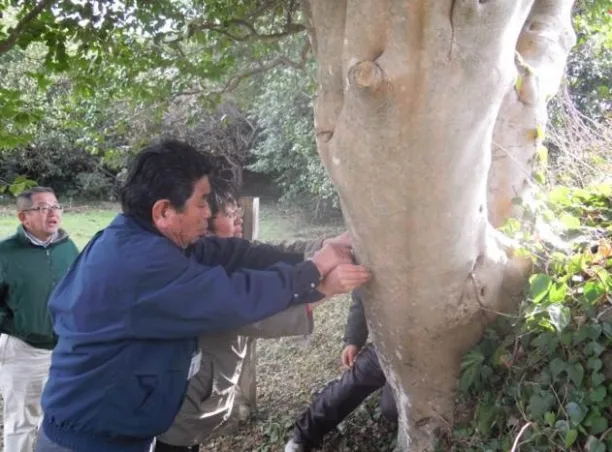
| Historic Camellias | 2004 | 2008 | 2011 |
| ‘Hoso-goryo’ | 200 | 201 | 202 |
| ‘Virgin Maria’ | 226 | 227 | 229 |
| ‘Toki-hime’ | 102 | 103 | 105 |
Protective Measures
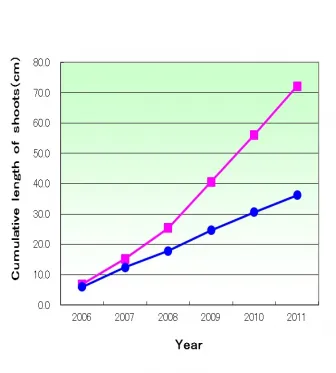 Camellia trees are strong and often used as wind breaks in the Goto areas. Old camellia trees planted around houses and farms are often found standing in poor soil or in the border where the requirements for tree growth are not easily available. Therefore, the improvement of the soil is essential for the preservation of important historic camellias. In 2006, an attempt was made to improve the growth of an historic, 250 year-old camellia tree named ‘Toki-hime’ tsubaki, by adding top soil as mulch. A truckload of topsoil was placed in a layer 30 cm thick around the trees on the slope to encourage good growth. Yearly growth measurements of new branches were taken to evaluate the effectiveness of the soil improvement. It is apparent that the soil improvement with topsoil is distinctly effective in stimulating new shoots as data in Fig. 2 indicate.
Camellia trees are strong and often used as wind breaks in the Goto areas. Old camellia trees planted around houses and farms are often found standing in poor soil or in the border where the requirements for tree growth are not easily available. Therefore, the improvement of the soil is essential for the preservation of important historic camellias. In 2006, an attempt was made to improve the growth of an historic, 250 year-old camellia tree named ‘Toki-hime’ tsubaki, by adding top soil as mulch. A truckload of topsoil was placed in a layer 30 cm thick around the trees on the slope to encourage good growth. Yearly growth measurements of new branches were taken to evaluate the effectiveness of the soil improvement. It is apparent that the soil improvement with topsoil is distinctly effective in stimulating new shoots as data in Fig. 2 indicate.
The crown of a camellia tree became greener than before showing a lush growth as Fig. 3 shows.
Prospective Development
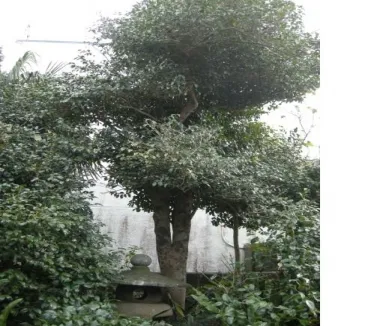 Encouraged by the results obtained, similar attempts with soil improvement were extended in 2011 to other historically important camellia trees of approximately 400 year-old in Goto, with additional improvements such as provision of irrigation pipes at strategically important points on the ground under the trees. Care was taken not to firm up the ground near the target trees after laying the topsoil, which is important to encourage the new shoot growth. Five open pipes (5 cm in diameter by 60 cm in length) were provided at the 6 meter radius from the main trunk of the camellia tree.
Encouraged by the results obtained, similar attempts with soil improvement were extended in 2011 to other historically important camellia trees of approximately 400 year-old in Goto, with additional improvements such as provision of irrigation pipes at strategically important points on the ground under the trees. Care was taken not to firm up the ground near the target trees after laying the topsoil, which is important to encourage the new shoot growth. Five open pipes (5 cm in diameter by 60 cm in length) were provided at the 6 meter radius from the main trunk of the camellia tree.
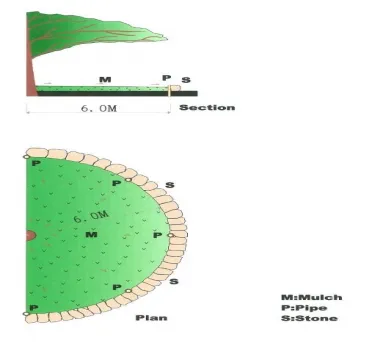 The outlines of the soil improvement for historic camellia trees named ‘Virgin Maria’ and ‘Hoso-Goryô are shown (Fig. 4).
The outlines of the soil improvement for historic camellia trees named ‘Virgin Maria’ and ‘Hoso-Goryô are shown (Fig. 4).
‘Virgin Maria’ tsubaki (Fig. 5) was so named because it was found to be the oldest tree in the farming area where camellia trees have been used as wind break by Christian farmers who came to the area about 200 years ago to escape severe religious oppression.
The tree has been protected carefully and admired by numerous visitors every year.
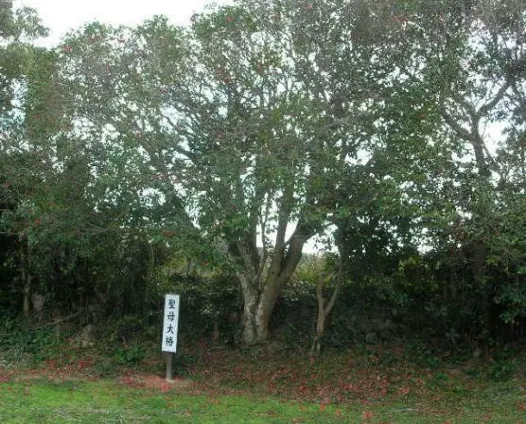 Hoso-goryô was a daughter of the ruler Uku Sumitaka who became one of the first Christian Daimyôs soon after the introduction of Christianity to Japan in 1549. She was a rare beauty at the time of Korean campaign by Toyotomi Hideyoshi (=Taikô) who wanted her to serve him in his residence. However, Hoso-Goryô chose her own death in defiance of his order so as to show her faithfulness to her husband. ‘Hoso-Goryô’ tsubaki (Fig. 6) is a counterpart of ‘Taikô’-tsubaki planted in front of the Genkai Nuclear Power Station, Genkai Town, Saga Prefecture. This project is in progress as a community project by volunteer workers. These historic camellia trees are important in the history of the Goto Achipelago and have numerous visitors during camellia festival.
Hoso-goryô was a daughter of the ruler Uku Sumitaka who became one of the first Christian Daimyôs soon after the introduction of Christianity to Japan in 1549. She was a rare beauty at the time of Korean campaign by Toyotomi Hideyoshi (=Taikô) who wanted her to serve him in his residence. However, Hoso-Goryô chose her own death in defiance of his order so as to show her faithfulness to her husband. ‘Hoso-Goryô’ tsubaki (Fig. 6) is a counterpart of ‘Taikô’-tsubaki planted in front of the Genkai Nuclear Power Station, Genkai Town, Saga Prefecture. This project is in progress as a community project by volunteer workers. These historic camellia trees are important in the history of the Goto Achipelago and have numerous visitors during camellia festival.
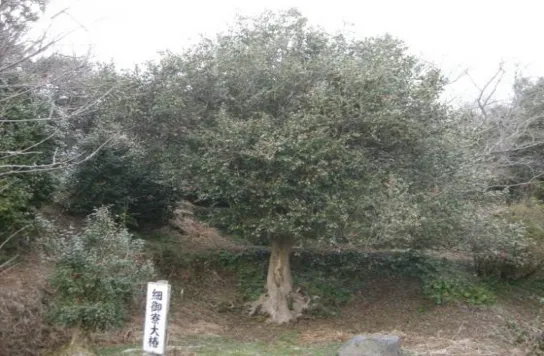 More than 20 giant camellia trees are to be found growing in different areas on Goto. In the future, each tree will be protected carefully and its unique characteristics will be recorded for proper comparison, as genetic diversity in Camellia japonica in the Goto Archipelago continues to be studied.
More than 20 giant camellia trees are to be found growing in different areas on Goto. In the future, each tree will be protected carefully and its unique characteristics will be recorded for proper comparison, as genetic diversity in Camellia japonica in the Goto Archipelago continues to be studied.
References
Hiruki, C. 2003-4. Camellia festival in Japan. Camellia Journal pp.4-5.
Hiruki, C. 2005. Camellias and Roman Catholic Churches in Japan. Proceedings of Locarno 2005 International Camellia Congress, 6 pages.
Hiruki, C. 2011. Investigation of Historic Giant Camellias in Goto Islands and Their Protection. Proceedings of the First International Symposium on Historic Camellias and New Camellia Species, 2 pages. (Full text in press in International Camellia Journal, 2011)
Web design by Tribal Systems
